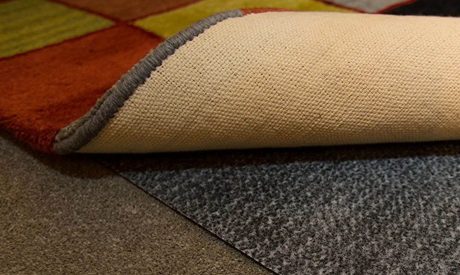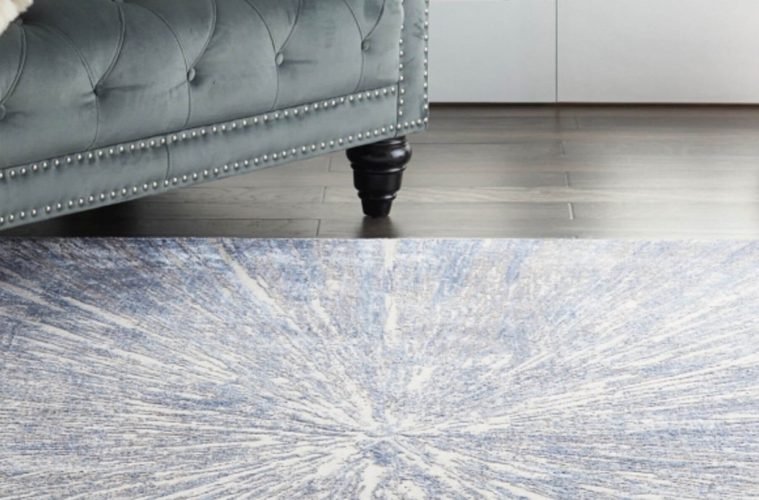The right rug can really help to enhance your home’s aesthetics. It can add pops of colour, rich textures and warmth to a room. Unfortunately, though, even if you’ve found the perfect spot for your rug, there’s no guarantee it will stay in place.
Even on carpeted floors, rugs can shift out of position over time. This can be frustrating as it affects the layout of the room. More importantly though, a moving rug can present a dangerous tripping hazard. To help you secure it safely in place, here’s some tips on how to stops rugs moving on carpet.
Why do rugs move on carpet?
You likely expect some movement from rugs placed on wooden or laminate floors. With carpeted floors though, you may think that the friction between the two fabrics will hold it in place. However, that’s not always the case.
As you walk over the carpet, your weight will push the carpet pile in the same direction as your movement. The pile is the soft fabric loops of your carpeting. As this happens, the carpet pile will cause any rugs placed on it to slowly move as well.
Thankfully, rather than constantly moving your rugs back into place, there are some handy steps you can take to stop a rug moving on carpet.
Add an anti-slip underlay to prevent rugs from moving

If you already have a rug that you want to keep in place, the quickest and easiest way to do this is by applying an anti-slip underlay product. Our Rug Anti-Slip Underlay can be applied to carpets and smooth flooring. It’s ideal for reducing the risks of slips, stopping curling of the carpet, maintaining the look of your rug and providing extra cushioning underfoot.
You will need to correctly measure the rug and cut the underlay to size – this can be done using household scissors. To ensure you don’t see the underlay when the rug is in place, you should subtract around 3-5cm from the length and width of your rug for the underlay measurement or, for round rugs, subtract this from the diameter measurement.
Once measured and cut, place the black side facing down onto the carpet and the grey side onto the rug or mat. If adhesion is lost from the underlay over time, it can be revived by using a fine spray of clean water and leaving to air dry.
Choosing the right rug for your space
When purchasing a new rug, it’s important to find the right one for your interiors. If you want the rug to be a focal point, then it’s worthwhile investing in a good quality one. Not only will this ensure it’s softer and more durable, but it can also help to minimise movement. Higher quality rugs tend to be thicker and heavier, which can help them remain in place more effectively.
It’s also important to consider the size of the rug for your space. Smaller rugs in areas with high foot traffic could present tripping hazards, so be sure to measure your floor space before making your purchase.
Opting for rugs with non-slip rubber backing is also recommended. This latex gel backing is more effective at gripping surfaces to combat creeping of the rug, although how well this works depends on the type of surface you’re placing it on. It’s a good idea to still use anti-slip underlay for rugs on plush or thick carpet piles.
Use furniture as an anchor

Using furniture as an anchor can be a good solution, particularly with larger area rugs. While it won’t completely stop any lifting of the corners, placing large items like sofas over a rug can help to pin it into place on any flooring type. You can choose to place multiple furniture items into the middle of the rug or just the front half of your seating or storage units for a more spacious feel.
However, this won’t prevent corners for curling. Also, for dining rugs, this technique may not work as well. As you will be frequently moving the dining chairs when using them. This will lead to the rug shifting and lifting in parts. To counteract this, you can apply underlay or tape to stop rugs moving.
How to stop a rug moving on laminate flooring, wood and other hard surfaces
Some rugs – particularly dining rugs and hall runners – are more likely to be placed on hard floors, such as woods and laminates. As these surfaces are smoother than carpet, they are more likely to skid and slip as you walk over them.
Thankfully, the solution to this is the same as with carpets. Applying our anti-slip underlay will add grip to your rug on any surface, as well as reducing abrasion on delicate floor surfaces. Measure and cut the same as you would when applying the underlay to carpet but instead, apply the grey side onto the smooth flooring and the black side on the rug.

